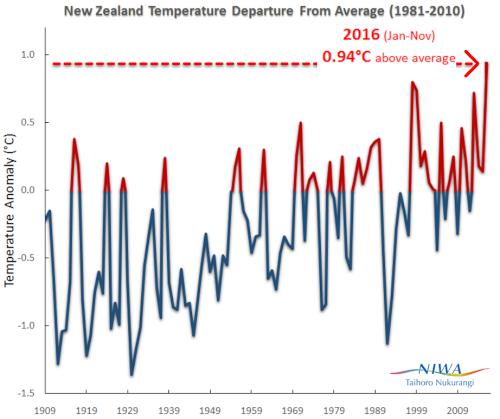2016 set to become New Zealand’s warmest on record

MEDIA RELEASE
TUESDAY, DECEMBER 13, 2016
2016 set to become New Zealand’s warmest on record
With just under three weeks until the end of the year, NIWA climate scientists say 2016 is set to be New Zealand’s hottest on record, breaking the previous record set in 1998.
Temperatures for the rest of the year would have to drop markedly to more than 1.0°C below normal for the next three weeks to avoid the record. However, NIWA forecasters say warmer than average temperatures are likely for the rest of December in the east of the both islands, with near average temperatures everywhere else.
NIWA climate data shows more than 70 places across the country are poised to set new mean temperature records. Auckland and Hamilton will most likely record their warmest year on record and Wellington its second warmest.
The national temperature observations date back to 1909. New Zealand’s mean temperature for 2016 is currently (January to November) running at 0.94°C above the 1981-2010 average. The previous warmest January-November year on record is 1999, when the temperature was 0.88°C above average.
The first seven months of the 2016 were all warmer than normal. Only August has been below normal this year.
Since the start of the national record in 1909, 35 years have been warmer than the 1981-2010 average. And this century only four years have recorded colder than average temperatures (2004, 2006, 2009, 2012).
NIWA principal scientist climate Dr Brett Mullan says the figures are in line with global average temperatures and confirm the longer-term trends of climate change.
“What we are seeing is the stark reality of global warming.” Dr Mullan said exceptionally warm conditions for the first six months of this year were a consequence of two main factors – the long-term regional warming trend due to greenhouse gas increase in the atmosphere, plus local natural variability adding extra warming.
“Natural variability acts like a tail wind or head wind, pushing local temperatures either above or below the long-term trend. In 2016, sea surface temperatures in the Tasman were exceptionally warm and there was more northerly flow than usual over New Zealand, pushing local temperatures above the trend.”
This late in the year it is evident that no weather station will record its coolest year on record.
Globally, the World Meteorological Organisation says 2016 is set to be the hottest year on record by a significant margin with temperatures 1.2°C above pre-industrial times. A new high will be set for the planet for the third year in a row.
The level of carbon dioxide in the atmosphere which has been steadily increasing for decades, also broke records this year, with May seeing the highest monthly value yet - 407.7 parts per million (ppm) - at Mauna Loa, in Hawaii.
At NIWA’s Baring Head Clean Air Station near Wellington, the 400ppm threshold was passed in June 2016, about three years after the 400ppm threshold was first broken at Hawaii.
Carbon dioxide is
the primary greenhouse gas contributing to warming of the
atmosphere
The final figures confirming New Zealand’s
2016 record will be available when NIWA releases its Annual
Climate Summary on January 9.


 Mānuka Charitable Trust: Mānuka Charitable Trust Warns Global Buyers Of Misleading Australian Honey Claims
Mānuka Charitable Trust: Mānuka Charitable Trust Warns Global Buyers Of Misleading Australian Honey Claims  Engineering New Zealand: NZ Building System Needs Urgent Improvement
Engineering New Zealand: NZ Building System Needs Urgent Improvement GNS Science: Bioshields Could Help Slow Tsunami Flow
GNS Science: Bioshields Could Help Slow Tsunami Flow Transport and Infrastructure Committee: Inquiry Into Ports And The Maritime Sector Opened
Transport and Infrastructure Committee: Inquiry Into Ports And The Maritime Sector Opened Netsafe: Netsafe And Chorus Power Up Online Safety For Older Adults
Netsafe: Netsafe And Chorus Power Up Online Safety For Older Adults RBNZ: 10 Cent Coin With King Charles III Image Now In Production
RBNZ: 10 Cent Coin With King Charles III Image Now In Production


